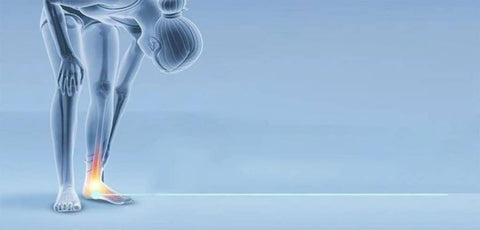Heel pain (also known as plantar fasciitis)is more common than you may think. One in ten of us will actually experience chronic heel pain at least once in our lives.1 While a sore heel is a nuisance at best, a little bit of patience and a few lifestyle adjustments can send you on your wav to getting back on your feet.1,2 Here’s how to treat and prevent the symptoms of heel pain.
What is Heel Pain?
In most cases. heel pain is caused by damage to the plantar fascia – the band of tissue connecting the heel bone to the other bones of the foot.3,4 A strained plantar fascia causes heel pain when you stand or walk, as the area becomes weakened, swollen or inflamed. Plantar fasciitis is one of the most common causes of heel pain.3,4
What are the Symptoms of Heel Pain?
The first step to treating heel pain, however mild or severe, is knowing what to look out for. Usually, it comes in the form of stabbing pain in the bottom of the heel.1,4-6
Typically, symptoms occur in the morning when you take your first steps after a night’s sleep. While this may improve throughout the day, it can reappear after prolonged standing and exercise.4-6
What Causes Heel Pain?
Strenuous or high-impact activities like running or jumping can give rise to heel pain.3 Plantar fasciitis is often the result of chronic overload and can occur whether you lead an active or sedentary lifestyle.6
What is the Best Heel Pain Treatment?
No matter the problem, there is a solution. Distinguish the difference between what needs treatment and what can be eased with the use of proper footwear and the best type of insole for you.
- Scholl GelActiv Everyday Insoles can help to keep you comfortable.7
- Scholl GelAcliv Work Insoles offer support to those working on their feet.8
- For anyone unable to live without their high heels, GelActiv Insoles for Her help give your high heels a sneaker feel.9
- To prevent heel pain on the field. Scholl GelActiv Sport Insoles are a great way of adding extra support to your trainers.10 The cushioning helps protect against the impact of the ground, helping you work out while avoiding strain and pressure. Speak to a specialist before picking out your next pair of sports shoes.
Learn more about Scholl’s range of insoles here.
How to Prevent Heel Pain
-
Exercise and stretch regularly.4
-
Wear comfortable footwear: heel pain due to shoes is very common.3
- Avoid shoes which are completely flat with no heel support: change your footwear if need be.
-
Keep an eye out for early warning signs and act preventatively.
How to Manage Heel Pain
-
Do not ignore your pain or discomfort.
- Rest from activities that stress the heel, use ice packs to reduce inflammation.3,4
- Take NSAID (non-steroidal anti-inflammatory) medication.2
-
Use insoles.3 Scholl insoles are available in major retailers and pharmacies in Australia including Coles, Woolworths, Chemist Warehouse and Priceline.
-
Seek medical help for heel pain if your symptoms don’t improve after 6-8 weeks.6
-
Massage the plantar fascia area.6
-
Do calf stretches.4
Optimising your general foot health
A simple maintenance routine can help to keep the skin on your feet supple and hydrated.
-
Daily care: Wash, dry and moisturise your feet thoroughly and every day.11
-
Footwear: Ensure that your shoes fit properly (both in width and length) and are right for your activity.12
-
Appearance: Check the appearance of your feet regularly for any changes.11
-
Movement and flexibility: Check that you can move your feet easily and without discomfort.12
-
Referral: Speak with your physiotherapist or podiatrist if you have any concerns.12
Conclusion
While your ailment won’t go away overnight, plantar fascia treatment is easy to do. With these simple recovery techniques, you could be back to walking, skipping or· running before you know it. Speak to your doctor or pharmacist if you have concerns about your foot health.
